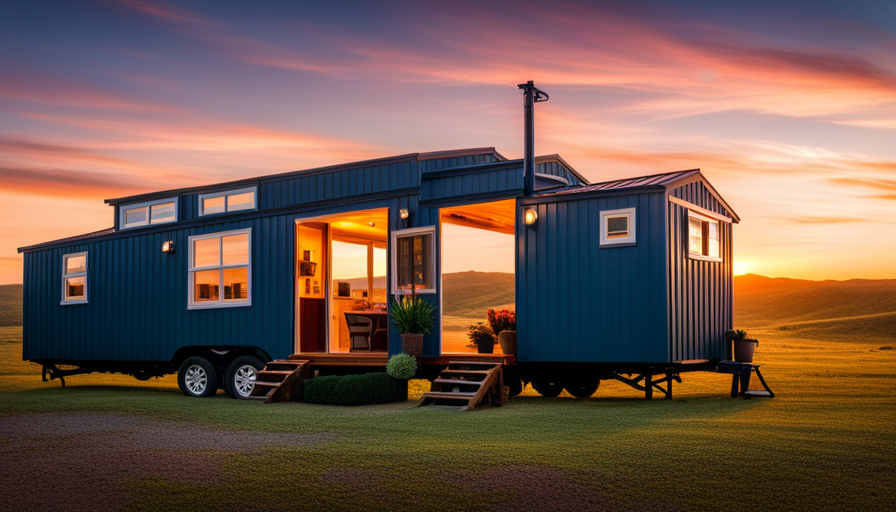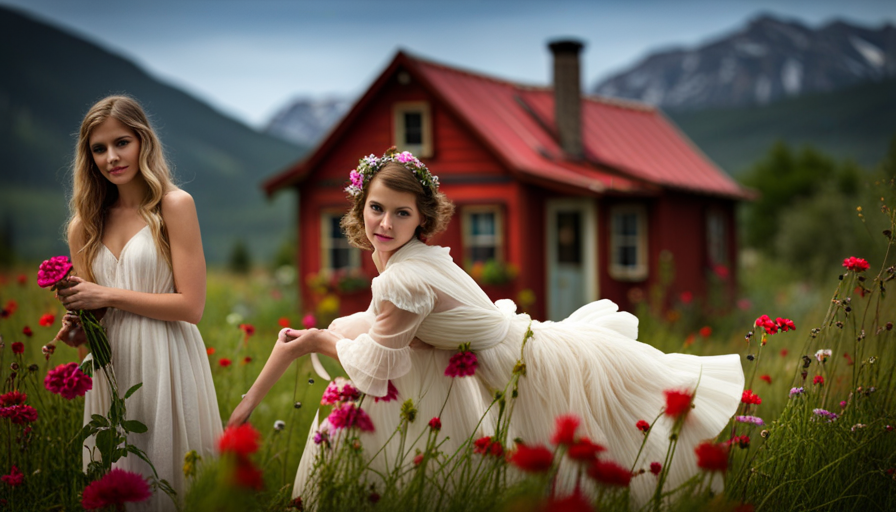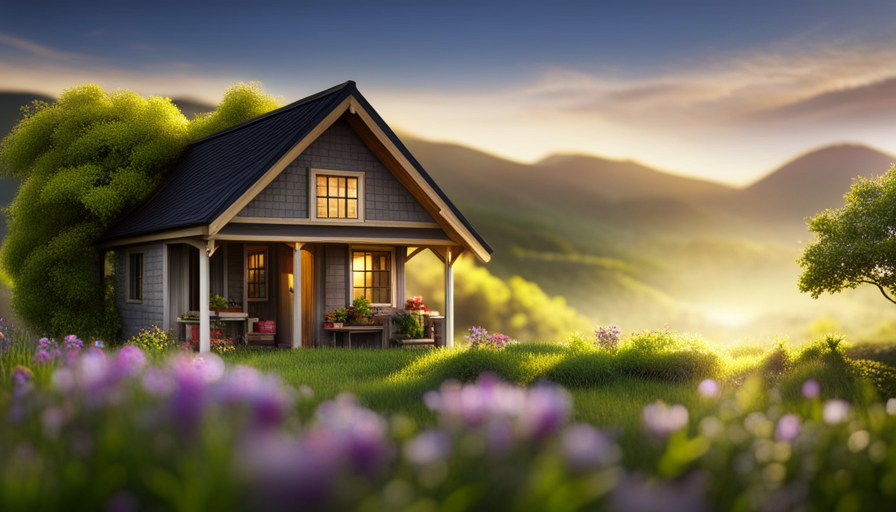Are you ready to simplify your life by downsizing to a smaller living space and embracing the minimalist lifestyle of tiny home living? Imagine living in a home so small, it feels like living in a dollhouse. A space where every square inch is carefully designed to maximize functionality and minimize clutter. Step into the world of tiny homes, where big dreams are housed in small spaces.
In this article, we will explore the fascinating world of tiny houses and answer the burning question: just how big is the average tiny house? Prepare to be amazed as we delve into the innovative storage solutions, space-maximizing designs, and cost considerations of these pint-sized dwellings. Whether you’re considering building your own tiny house or buying one, we have the resources and examples to guide you on your journey.
So, if you’re ready to trade excess for simplicity and embrace a minimalist lifestyle, join me on this exciting exploration of the average size of tiny houses. Prepare to be inspired and discover how these small spaces can lead to big possibilities.
Key Takeaways
- The average square footage of a tiny house is around 400-600 square feet.
- Tiny houses can range in size from 100 square feet to 1,000 square feet.
- The cost of a tiny house can range from $20,000 to $100,000.
- Designers maximize space in tiny house design through strategic layouts and clever design elements.
The Definition of a Tiny House
So, how big is the average tiny house? To answer this question, we need to understand the definition of a tiny house and the regulations surrounding them.
Tiny houses are typically small, compact homes that are designed to maximize space and minimize waste. They are often built on wheels, allowing for mobility and flexibility. However, there are certain regulations that dictate the size of a tiny house. For example, in the United States, the maximum width is usually 8.5 feet and the maximum height is 13.5 feet. These regulations ensure that tiny houses can be transported safely on the roads.
In addition to regulations, tiny house communities have also influenced the size of these homes. Many communities have specific guidelines regarding the size of tiny houses to ensure a cohesive and harmonious living environment. These guidelines often require a maximum square footage, which can vary from community to community.
Transitioning into the next section about the average square footage of tiny houses, it is important to consider both the regulations and community guidelines that influence their size.
The Average Square Footage of Tiny Houses
The typical size of a compact dwelling often ranges between a few hundred and a thousand square feet. Tiny houses are designed to maximize space and minimize unnecessary square footage. The average square footage of a tiny house is around 400-600 square feet, although some may be as small as 100 square feet or as large as 1,000 square feet. To give you a better idea of the size range, here is a breakdown of the average square footage of tiny houses:
| Size Range | Square Footage |
|---|---|
| Small | 100-400 sq ft |
| Medium | 400-800 sq ft |
| Large | 800-1,000 sq ft |
When considering a tiny house, it’s important to factor in the average cost and zoning regulations. The cost of a tiny house can vary greatly depending on factors such as location, materials used, and customizations. On average, the cost of a tiny house ranges from $20,000 to $100,000. Zoning regulations also play a role in determining the size and location of a tiny house. Many cities have specific regulations for tiny houses, including minimum square footage requirements and restrictions on where they can be parked or placed.
Moving on to the next section about common features and layouts of tiny houses, it’s important to consider the space-saving techniques used in these compact dwellings.
Common Features and Layouts of Tiny Houses
One popular feature of compact dwellings is the clever use of multifunctional furniture and storage solutions. This allows for maximum utilization of space in tiny houses.
Common materials used in tiny house construction include wood, metal, and recycled materials. These materials are chosen for their durability and ability to withstand the challenges of a small living space. In addition to being made from sustainable materials, many tiny houses also incorporate energy-efficient design elements. This includes features such as solar panels, energy-efficient appliances, and insulation that helps to regulate temperature and reduce energy consumption.
When it comes to the layout of tiny houses, there are a few common configurations. One popular layout is the open floor plan, which maximizes the use of space by eliminating unnecessary walls and creating a sense of openness. Another common layout is the loft design, where the sleeping area is elevated to create more usable space on the main level.
Innovative storage solutions are a key component of tiny house design. From hidden compartments in stairs to built-in shelving units, these solutions help to maximize storage space in a small footprint.
This seamless transition to the subsequent section about ‘innovative storage solutions in tiny houses’ highlights the importance of efficient storage in these compact dwellings.
Innovative Storage Solutions in Tiny Houses
Let’s explore the innovative storage solutions found in compact dwellings and discover that 85% of tiny house owners utilize hidden compartments and built-in shelving units to maximize their storage space.
In order to make the most of the limited square footage available in tiny houses, creative storage ideas are a must. One popular solution is the use of space-saving furniture, such as foldable tables and chairs that can be tucked away when not in use. Another innovative storage idea is the use of multi-functional furniture, like beds with built-in drawers or ottomans that double as storage boxes. These ingenious designs allow tiny house owners to have the functionality they need without sacrificing precious space.
Additionally, maximizing vertical space is crucial in tiny house design. Shelving units and wall-mounted storage systems are commonly used to take advantage of vertical space and keep belongings organized. By incorporating these innovative storage solutions, tiny house owners can create a clutter-free living environment while still having everything they need within reach.
In the next section, we will explore how designers maximize space in tiny house design by utilizing strategic layouts and clever design elements.
Maximizing Space in Tiny House Design
Create a living environment that feels expansive and liberating, allowing you to fully embrace the freedom and simplicity of tiny house living by maximizing space in your design.
In order to make the most of the limited square footage available in a tiny house, it’s essential to focus on maximizing functionality and incorporating space-saving techniques.
To achieve this, there are several strategies that can be employed:
-
Utilize multi-purpose furniture: Opt for pieces that can serve more than one function, such as a sofa that can also be used as a bed, or a dining table that can be folded up and stored when not in use.
-
Embrace vertical space: Take advantage of the height of your tiny house by incorporating tall shelves or loft areas for storage. This will help to free up valuable floor space.
-
Implement smart storage solutions: Utilize hidden storage compartments and built-in organizers to keep belongings organized and out of sight. This will help to create a clutter-free living environment.
-
Use light colors and mirrors: Light colors and mirrors can create the illusion of a larger space. Opt for light-colored walls and furniture, and strategically place mirrors to reflect light and make the space feel more open.
By incorporating these space-saving techniques, you can create a tiny house that not only feels spacious and functional but also allows you to fully enjoy the benefits of living in a small and simplified space.
The Benefits of Living in a Tiny House
Experience the freedom and simplicity of embracing a minimalist lifestyle in a compact living space, where every nook and cranny holds the potential for joy and fulfillment. Living in a tiny house has numerous benefits, both psychological and environmental. Downsizing to a smaller space can have a profound psychological impact, allowing individuals to declutter their lives and focus on what truly matters. With less space to fill, one can prioritize experiences and relationships, leading to increased happiness and contentment.
In addition to the psychological benefits, living in a tiny house also has positive environmental implications. These small homes have a significantly smaller carbon footprint compared to traditional houses. They require less energy to heat and cool, resulting in lower utility bills and reduced energy consumption. Furthermore, tiny houses often utilize sustainable materials and incorporate eco-friendly technologies, such as solar panels and rainwater harvesting systems.
By living in a tiny house, individuals can actively contribute to a more sustainable future while enjoying a simpler and more fulfilling lifestyle. However, it’s important to consider the challenges and considerations that come with tiny house living, such as limited storage space and zoning regulations. Despite these challenges, the rewards of tiny house living are undeniable, making it a viable option for those seeking a more sustainable and meaningful way of life.
Challenges and Considerations of Tiny House Living
Embrace the hurdles and navigate the complexities of downsizing to a smaller living space, for as the saying goes, ‘A smooth sea never made a skilled sailor.’
Living in a tiny house comes with its fair share of challenges and considerations. While the idea of simplifying your life and reducing your environmental footprint may sound appealing, it’s important to be aware of the potential difficulties that may arise.
One of the main challenges of tiny house living is the limited space. With such a small footprint, every square inch needs to be utilized efficiently. Storage becomes a crucial consideration, as finding adequate space for your belongings can be a real struggle. Additionally, the lack of privacy can be a challenge for some individuals, as there are no separate rooms or designated areas for different activities.
Another consideration is the zoning regulations and building codes that vary from one location to another. Depending on where you plan to park your tiny house, you may face legal restrictions or difficulties obtaining permits. It’s essential to thoroughly research the regulations in your desired area before committing to the tiny house lifestyle.
Despite these challenges and considerations, many people have found creative solutions to make tiny house living work for them. From innovative storage solutions to clever furniture designs, there are countless examples of how people have made the most out of their limited space.
Transitioning to the next section, let’s explore some inspiring examples of creative tiny house designs.
Examples of Creative Tiny House Designs
Imagine stepping into a world where every nook and cranny serves a purpose, where hidden compartments and multi-functional furniture effortlessly transform a compact space into a stunning and functional masterpiece. This is the realm of creative tiny house designs, where architects and homeowners alike have pushed the boundaries of small space living to create truly unique and innovative solutions.
One example of a creative tiny house design is the use of loft spaces. By incorporating loft bedrooms or lounges, homeowners can maximize vertical space and create a sense of openness.
Another design trend is the use of sliding walls or partitions, which allow for flexible room configurations and the ability to create separate spaces when needed.
In addition, many tiny house designs feature built-in storage solutions, such as under-stair storage or hidden compartments in furniture. These clever design elements help to minimize clutter and maintain a clean and organized living space.
Transition: Now that we have explored the examples of creative tiny house designs and the unique small space solutions they offer, let’s delve into the cost considerations of building or buying a tiny house.
Cost Considerations of Building or Buying a Tiny House
Now let’s delve into the financial aspects of creating or purchasing a compact living space. When it comes to tiny houses, one of the first considerations is the cost comparison between building and buying. Building a tiny house allows for more customization and control over the overall cost, but it requires time, effort, and construction skills. Buying a pre-built tiny house, on the other hand, may be more convenient, but it can be more expensive.
Financing options for tiny houses vary depending on whether you choose to build or buy. For those building their own tiny house, personal savings or loans from family and friends are common sources of financing. Additionally, some banks offer loans specifically designed for tiny house construction. On the other hand, if you decide to buy a pre-built tiny house, financing options can include traditional mortgages or RV loans.
When considering the cost of a tiny house, it’s important to factor in additional expenses such as land, utilities, and ongoing maintenance. These costs can vary greatly depending on location and personal preferences. It’s also worth noting that while tiny houses can be a more affordable housing option in the long run, the initial investment may still be significant.
Now that we have discussed the cost considerations of building or buying a tiny house, let’s explore the resources available for those interested in creating their own compact living space.
Resources for Building or Buying a Tiny House
With a plethora of online forums, books, and workshops available, individuals interested in creating their own compact living space can find a wealth of resources to guide them through the process.
When it comes to financing a tiny house, there are various options available. One resource is to explore loans specifically designed for tiny houses, which can help cover the costs of construction or purchasing. Additionally, crowdfunding platforms can be a creative way to raise funds for a tiny house project. These platforms allow individuals to share their plans and gather support from friends, family, and even strangers who’re passionate about the tiny house movement.
In terms of the environmental impact of tiny houses, there are resources available to help individuals make sustainable choices. Many tiny house enthusiasts prioritize eco-friendly materials and energy-efficient systems. Online communities and forums provide a space for individuals to share tips and resources on sustainable building practices, such as using salvaged materials or installing renewable energy sources like solar panels. Furthermore, there are workshops and courses focused on sustainable living and building techniques that can provide valuable knowledge and guidance.
The resources available for building or buying a tiny house are extensive. Whether it’s finding financial support or learning about eco-friendly options, individuals interested in the tiny house movement can access a wealth of information to help them create their dream compact living space.
Frequently Asked Questions
How much does it cost to maintain a tiny house?
Maintaining a tiny house can be cost-effective. The cost of utilities in a tiny house is generally lower compared to traditional homes due to their smaller size. Off-grid living in a tiny house allows for self-sufficiency, reducing reliance on public utilities. However, there are pros and cons to consider.
While it may reduce monthly expenses, off-grid living requires careful planning and investment in alternative energy sources. Overall, the cost of maintaining a tiny house depends on individual choices and lifestyle preferences.
Can a tiny house be built on wheels?
Yes, a tiny house can be built on wheels. Building a tiny house on wheels allows for greater flexibility and mobility. However, it’s important to consider building codes and parking regulations when constructing a tiny house on wheels. These regulations vary depending on the location, so it’s crucial to research and comply with the specific requirements of the area where the tiny house will be parked.
Are there any zoning restrictions for tiny houses?
Zoning restrictions and legal concerns are important considerations for tiny house enthusiasts. These regulations vary depending on the location, but they often dictate where a tiny house can be placed and how it should be constructed.
Some areas have minimum square footage requirements, while others may require a permanent foundation. It’s crucial to research and understand these restrictions before embarking on a tiny house project to ensure compliance and avoid potential legal issues down the road.
In this regard, zoning regulations act as a compass, guiding us through the complex landscape of tiny house living.
What are the most common heating and cooling systems used in tiny houses?
The most common heating options and cooling solutions used in tiny houses are typically compact and energy-efficient. For heating, popular choices include propane or electric heaters, wood-burning stoves, and mini-split systems. These options provide effective warmth while minimizing space usage.
As for cooling, many tiny house owners opt for ceiling fans, portable air conditioners, or even strategic window placement to maximize airflow and ventilation. It’s essential to consider the climate and energy needs when selecting the most suitable heating and cooling systems for a tiny house.
Do tiny houses have plumbing and bathroom facilities?
Oh, let me tell you, the world of tiny houses is truly a marvel. While these pint-sized abodes may lack in size, they certainly don’t skimp on creativity. Now, when it comes to plumbing options and bathroom design, rest assured that tiny houses have got you covered.
Despite their compact nature, these tiny wonders can be equipped with all the necessary facilities to keep you fresh and clean. From composting toilets to clever space-saving bathroom layouts, there’s no limit to the ingenuity found in the world of tiny house bathrooms.
Conclusion
In conclusion, the average size of a tiny house may vary, but it’s typically around 400 square feet.
These compact homes are designed to maximize every inch of space, with innovative storage solutions and creative layouts.
Living in a tiny house can be both challenging and rewarding, requiring careful consideration of one’s lifestyle and needs.
However, the cost savings and freedom of living a minimalist life can be truly liberating.
Just like a tiny seed that grows into a mighty tree, a tiny house has the potential to provide a simple and fulfilling life.
Hi, I’m Emma. I’m the Editor in Chief of Tiny House 43, a blog all about tiny houses. While tree houses are often associated with childhood, they can be the perfect adult retreat. They offer a cozy space to relax and unwind, surrounded by nature. And since they’re typically built on stilts or raised platforms, they offer stunning views that traditional homes simply can’t match. If you’re looking for a unique and romantic getaway, a tree house tiny house might just be the perfect option.










